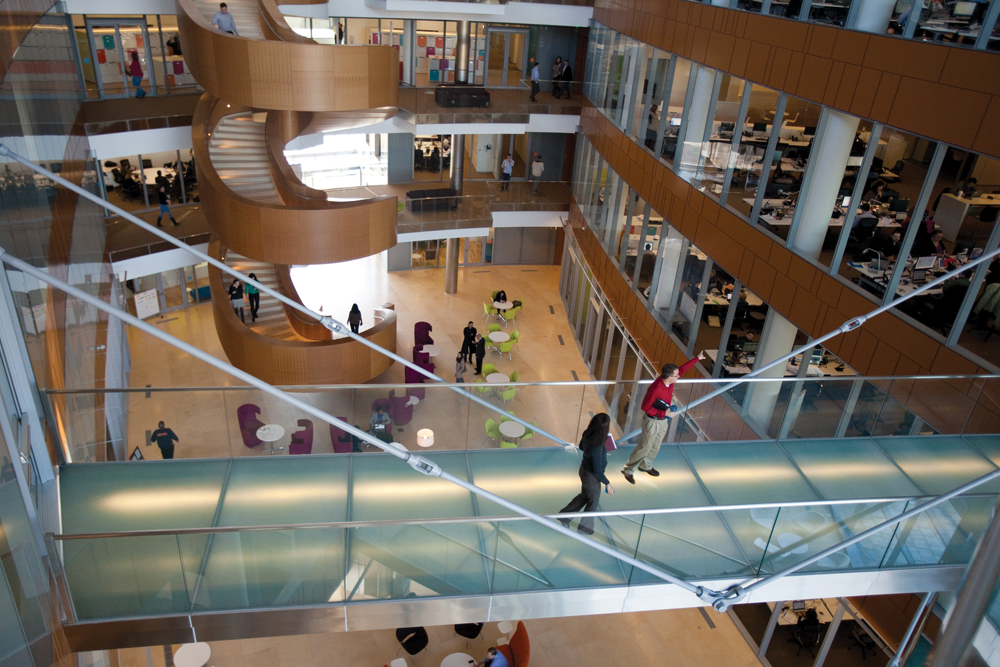Many firms that do office design and construction stayed afloat during the recession with modest projects—fit-outs, renovations, targeted green retrofits. But the sector’s finally heating up.
Commercial Realtors recently reported an increase in annual gross income for the third year in a row (www.BDCnetwork.com/Realtors2013). Jones Lang LaSalle’s latest office forecast pegged more than a dozen metros as being in “a rising phase,” including Austin, Dallas, Boston, Denver, Pittsburgh, Indianapolis, and New York (http://bit.ly/JLLOffice13).
Though speculative projects still lag, corporate HQs and medical office buildings are moving ahead. “The medical office building of the future can accommodate much of what was done in a traditional hospital setting,” says Steve Straus, President of Glumac. “Some of our clients have bold ambitions, including net-zero.”
TOP OFFICE SECTOR ARCHITECTURE FIRMS
2012 Office Revenue ($)1 Gensler $462,700,5002 HOK $128,726,0003 Perkins+Will $107,951,6724 NBBJ $64,002,0005 Stantec $62,500,2366 PageSoutherlandPage $43,190,0007 Heery International $39,443,9318 Kohn Pedersen Fox Associates $38,081,0009 RTKL Associates $37,474,00010 Hammel, Green and Abrahamson $37,307,000
TOP OFFICE SECTOR ENGINEERING FIRMS
2012 Office Revenue ($)1 AECOM Technology Corp. $830,320,0002 Parsons Brinckerhoff $146,400,0003 Jacobs Engineering Group $95,180,0004 Burns & McDonnell $82,020,0005 Thornton Tomasetti $50,861,4676 Michael Baker Jr. $50,720,0007 WSP USA $48,500,1628 Arup $32,355,6079 Buro Happold Consulting Engineers $28,720,00010 AKF Group $26,917,000
TOP OFFICE SECTOR CONSTRUCTION FIRMS
2012 Office Revenue ($)1 Turner Corporation, The $2,195,790,0002 Structure Tone $1,435,332,0003 PCL Construction Enterprises $1,409,212,7274 Clark Group $974,974,0665 Skanska USA $847,106,2426 Balfour Beatty $792,915,5767 Gilbane $690,915,0008 JE Dunn Construction $613,825,5639 James G Davis Construction $575,006,00010 HITT Contracting $535,524,009
On the West Coast, tech firms are creating eye-popping campuses, including NBBJ projects for Amazon (Seattle, 3.3 million sf); Samsung (San Jose, 1.1 million sf, with Arup); and Google (Mountain View, Calif., 1 million sf). Facebook tapped Frank Gehry to design its 420,000-sf Facebook West in Menlo Park, Calif., and Foster + Partners is designing Apple’s 2.8 million-sf, net-zero Campus 2 in Cupertino (to be built by DPR-Skanska.)
Bleeding-edge companies seek the latest in social engineering and sustainability, but they’re not alone in believing that generational and technological trends justify a reboot in office design. “The relevance of ‘the office’ is in question,” says Steve Hart, Director of Interior Design at Heery. “Why are you even in an office? We believe the office needs to help individuals feel connected to the company and support a common sense of purpose.”
Read BD+C's full Giants 300 Report
Related Stories
| Aug 11, 2010
Great Solutions: Healthcare
11. Operating Room-Integrated MRI will Help Neurosurgeons Get it Right the First Time A major limitation of traditional brain cancer surgery is the lack of scanning capability in the operating room. Neurosurgeons do their best to visually identify and remove the cancerous tissue, but only an MRI scan will confirm if the operation was a complete success or not.
| Aug 11, 2010
Great Solutions: Collaboration
9. HOK Takes Videoconferencing to A New Level with its Advanced Collaboration Rooms To help foster collaboration among its 2,212 employees while cutting travel time, expenses, and carbon emissions traveling between its 24 office locations, HOK is fitting out its major offices with prototype videoconferencing rooms that are like no other in the U.
| Aug 11, 2010
2009 Judging Panel
A Matthew H. Johnson, PE Associate Principal Simpson Gumpertz & HegerWaltham, Mass. B K. Nam Shiu, SE, PEVP Walker Restoration Consultants Elgin, Ill. C David P. Callan, PE, CEM, LEED APSVPEnvironmental Systems DesignChicago D Ken Osmun, PA, DBIA, LEED AP Group President, ConstructionWight & Company Darien, Ill.
| Aug 11, 2010
Inspiring Offices: Office Design That Drives Creativity
Office design has always been linked to productivity—how many workers can be reasonably squeezed into a given space—but why isn’t it more frequently linked to creativity? “In general, I don’t think enough people link the design of space to business outcome,” says Janice Linster, partner with the Minneapolis design firm Studio Hive.
| Aug 11, 2010
BIM school, green school: California's newest high-performance school
Nestled deep in the Napa Valley, the city of American Canyon is one of a number of new communities in Northern California that have experienced tremendous growth in the last five years. Located 42 miles northeast of San Francisco, American Canyon had a population of just over 9,000 in 2000; by 2008, that figure stood at 15,276, with 28% of the population under age 18.







